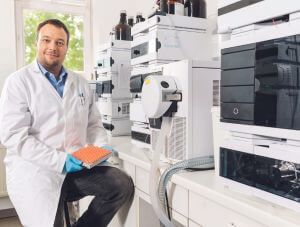
When the Dr Ehrenstorfer company was born 50 years ago, the world was only just beginning to realise the full extent of its environmental problems. Immediately after being set up in 1975, the new firm set out to provide a solution to one of the biggest issues of the age – the indiscriminate use of pesticides – and has carried on for five decades in the same bold spirit of innovation. As well as growing into the world’s leading supplier of pesticide reference materials, Dr Ehrenstorfer has constantly expanded its environmental and food standards portfolio to help the world monitor, understand and address an ever-widening list of pollutants – including polychlorinated biphenyls (PCBs), per-and polyfluoroalkyl substances (PFAS), human and veterinary drug residues, and microplastics. In this special 50th birthday article, we look back at how Dr Ehrenstorfer’s expert scientists embraced both the spirit of progress and cutting-edge science to help tackle the environmental and food safety problems of each decade.
“Groundbreaking stuff”: Dr Ehrenstorfer in the 1970s
As the United States Environmental Protection Agency (US EPA) puts it, “The... conversation about protecting the environment began in the 1960s”, inspired by Rachel Caron’s attack on pesticide overuse in her book Silent Spring. But it wasn’t until the following decade that concrete environmental action started to happen. In 1970, US President Richard Nixon responded to a shocking fire a year earlier in Ohio’s pollution-choked Cuyahoga River by proposing a $4 billion, 37-point, environmental clean-up plan to Congress. Amongst other things, the plan led to the establishment of the US EPA and to greatly improved controls on environmental contaminants – such as EPA methods for identifying and quantifying a huge range of pollutants. The year 1976 saw maximum levels for pesticide residues on fruit and vegetables applied across Europe, but when German regional authorities tried to introduce their own pesticide testing regulations, scientists quickly realised there was a problem: “No-one was able to apply the regulations correctly in the lab because there were no reference materials available,” recalls Dr Ehrenstorfer’s Philipp Feuerriegel. “So Dr Ehrenstorfer took on the challenge and said: ‘Well, if there are none available, we will create them’. I think at the time, in Europe at least, there were only two producers. So it was quite groundbreaking stuff.”
The 1980s: mixtures and Montreal
The global effort to address environmental challenges gathered pace during the 1980s, and in 1985, scientists revealed a huge hole in the ozone layer that protects life on Earth from harmful solar radiation. Their findings led directly to the 1987 Montreal Protocol - a global agreement freezing production and consumption of ozone-depleting substances like chlorofluorocarbons (CFCs), that has enabled the ozone hole to recover this century. Analytical science also progressed significantly in the ’80s, including improvements in spectroscopy and chromatography, which enhanced the precision of chemical analysis, and also contributed to the development of better Dr Ehrenstorfer products. In 1988, the company introduced its first pesticide reference materials mixtures to the market – responding to improvements in analytical equipment that meant customers in testing laboratories could now screen and check multiple analytes in one run. “At the end of the 1980s, the labs, the methods and the instruments were so good that customers could measure mixtures for the first time,” Dr Ehrenstorfer’s Jens Seltmann explained. “And that’s why we started that business.”
The 1990s: EPA methods, and environment-friendly chemistry
Regulatory developments provided the impetus for further environmental improvements in the 1990s. Firstly, the US Pollution Prevention Act of 1990 - which sought to reduce contamination by designing better production methods – prompted scientists to develop new Green Chemistry principles for processes and products that minimised environmental impacts. Meanwhile, the US EPA became the first regulatory authority to publish methods specifying the number and type of analytes that laboratories were required to include in their testing – prompting another exciting development for the Dr Ehrenstorfer business: method-specific mixtures that made life in a lab much easier. “Rather than giving the customer 30 part numbers for neat materials, we produced mixtures for EPA methods such as 505 and 508, with all the analytes for the methods in there,” recalls Jens Seltmann. “The advantage for the customer is that the mixture is a ready-to-use product – you can buy it, open the ampoule and just use it as it is.”
Dr Ehrenstorfer reference materials – born from 50 years of scientific expertise
Over the last 50 years, Dr Ehrenstorfer has developed an extensive range of reference materials that analytical laboratories trust when testing for contaminants in environmental, food and food contact samples – including pesticides, PFAS, PCBs, drug residues, microplastics, microbes, and mycotoxins.
Dr Ehrenstorfer guarantees customers quality they can rely on – with over half of its reference materials manufactured under the scope of its ISO 17034 accreditation, and Certificate of Analysis measurements carried out in accordance with ISO/IEC 17025. It also offers a comprehensive range of standards designed to support compliance with US, Asia Pacific, and EU testing methods.
The ISO 17034-accredited Smart Solutions™ iMix range from Dr Ehrenstorfer meanwhile features state-of-the-art multi-residue mixtures for testing hundreds of PFAS, pesticides, terpenes, and drug residues – offering optimal analyte elution and maximum stability, and increasing efficiency by reducing the need for complicated method development or dilution steps.
|
The 2000s: new century, new problems and solutions
Although the world survived the much-feared Millennium Bug unharmed, some big – and unavoidable - environmental problems were also looming at the start of the 21st century. The first regulatory actions against PFAS came in this decade, following decades of concerns about the effects of the “forever chemical” perfluorooctanoic acid (PFOA) on US manufacturing workers and water supplies. Meanwhile, around 180 countries signed up to the 2004 Stockholm Convention on Persistent Organic Pollutants (POPs) in an attempt to mitigate the harmful effects of dozens of legacy industrial compounds – including PFAS and PCBs. Recognising the need for reliable reference materials to enable meaningful testing and research, Dr Ehrenstorfer has developed market-leading portfolios for both PFAS and PCBs – featuring almost 700 products, all of which are accredited to either ISO 17034 and/or ISO/IEC 17025.
The 2010s: completing the jigsaw
Commercial decisions took Dr Ehrenstorfer to new heights during the 2010s. The German company was acquired by UK-based LGC in January 2014 - significantly boosting the financial, research and intellectual firepower of what was already the world’s leading provider of pesticide standards, while Charleston-based o2si Smart Solutions also added crucial scientific expertise from 2016. Ultimately, the two acquisitions would help Dr Ehrenstorfer to develop and launch its revolutionary portfolio of multi-analyte mixtures - which today features the Smart Solutions ™ iMix range for testing PFAS (PFASiMix), pharmaceutical and veterinary drug residues, (Pharma Vet ResiMix), pesticides (PestiMix), and terpenes, (TerpiMix) - as well as a dedicated polybrominated biphenyls mixture (PBB Mix5) to enhance our extensive flame retardants range. “I think (the acquisitions were) a bit like completing a jigsaw puzzle,” said LGC’s Kelly Cheshire. “Because – very broadly speaking - the strength of the (German) site is in neat materials and catalogue products, and Charleston’s strength was traditionally in customised solutions. That coming together meant Dr Ehrenstorfer was able to provide the whole solution for its customers, because then every format was covered – wherever they were in the world, however they wanted to receive that product for their lab, we could supply it.”
The 2020s: fantastic solutions for microplastics, and more to come...
Microplastic pollution has been a global problem for longer than you might think. Recent research from the Netherlands found tiny plastic particles in protective caddisfly casings that were collected back in 1971, while the term “microplastics” has now been in use for more than 20 years. Evidence of the ubiquity of microplastic contamination – such as in food and fertilisers, human blood samples and placentas – continues to mount. But despite the clear environmental dangers, we have not yet been able to develop satisfactory methods for analysing microplastics – chiefly due to the lack of high-quality microplastic reference standards. This year, however, Dr Ehrenstorfer released a game-changing range of microplastics reference materials, featuring the most common microplastics encountered in analysis: polyethylene (PE) and polypropylene (PP), plus nylon (N66) and polyester (PET) fibres. The new range is also unique in offering both fibres and spherical particles, meaning that our customers can test a full range of microplastics at once – not only improving productivity and profitability, but also establishing a positive, forward-facing reputation for themselves, as they work towards better consumer and environmental safety.
The microplastics range also brilliantly confirms Dr Ehrenstorfer’s commitment to continuous innovation, and to providing laboratories with a constant supply of new and original products for analysis and research. This year, we’ve updated our PCBs range by introducing new ISO 17034-accredited, 13C labelled reference materials - designed for studying the toxic effects of PCBs on living organisms, but also ideal for use as internal standards in routine testing. We’ve also upgraded our v700 LC PestiMix kit by adding scores of new analytes that our customers requested, tripling shelf life to up to three years, and doubling the concentration to10ppm: enabling use both as a spike and for instrument calibration.



